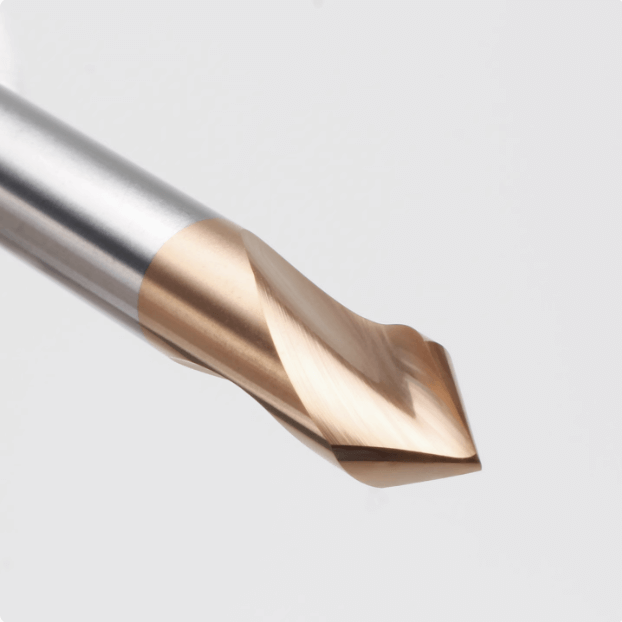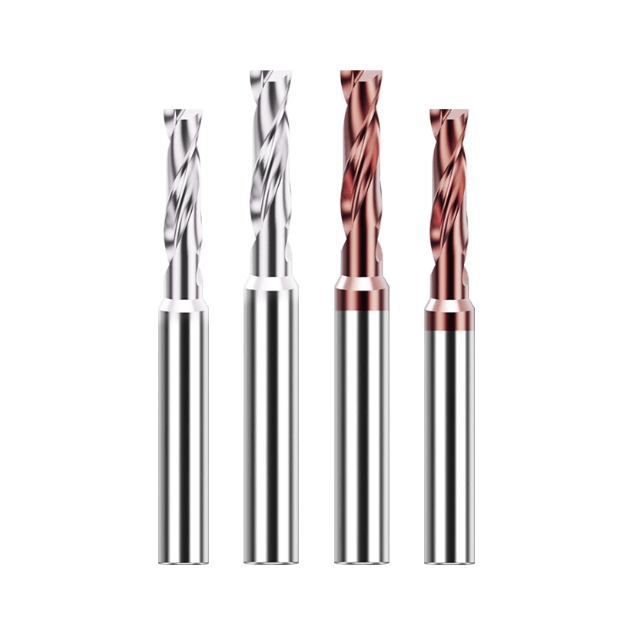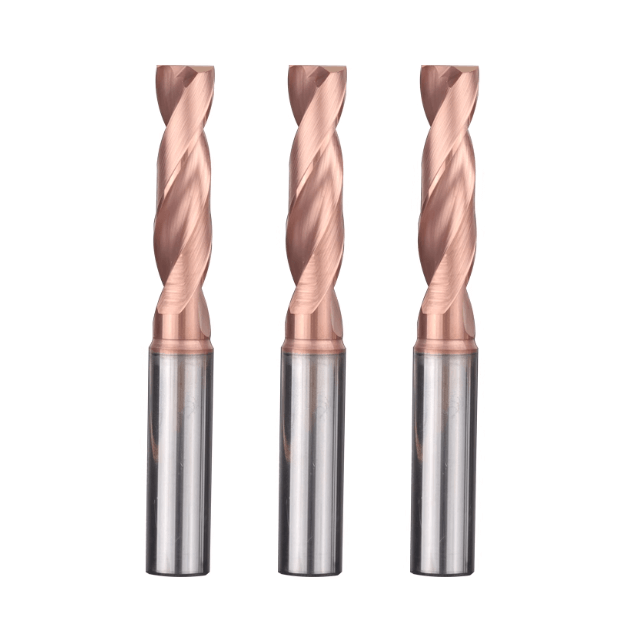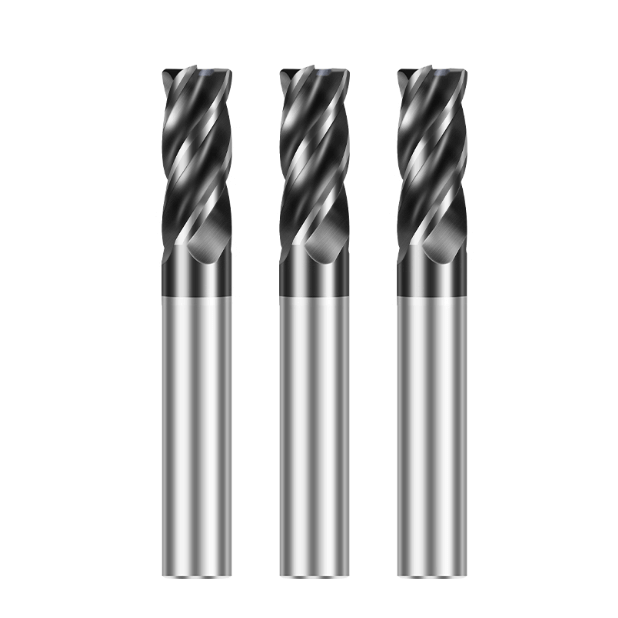Deep hole drilling places extremely high demands on tool performance, precision, and process stability. The choice of drill bit directly impacts hole accuracy, surface finish, and overall productivity. For manufacturers drilling high-hardness materials such as hardened steel, stainless steel, and titanium alloys, carbide tipped drill bits offer superior wear resistance, thermal stability, and cutting-edge retention, making them essential for improving machining efficiency and consistency.
Compared to traditional high-speed steel (HSS) drill bits, carbide-tipped drill bits maintain sharp cutting edges at higher speeds and feeds, reducing tool change frequency and significantly extending tool life. In CNC precision drilling, these drill bits not only address chip evacuation and heat dissipation challenges typical in deep-hole operations but also maintain stable hole diameter and coaxiality during long machining cycles.
Selecting the appropriate drill geometry, coating type, and cooling method is critical when drilling hardened steel or other high-strength alloys. With the growing demand for bulk carbide drill bits for B2B supply, manufacturers are increasingly focusing on standardized drill specifications and OEM customization options to achieve both cost control and process optimization.
Overall, successful deep-hole drilling depends not only on tool material performance but also on an engineer’s understanding of drill design, process parameters, and machining strategy. Choosing the right carbide-tipped drill bit is fundamental to achieving high-efficiency, high-precision drilling and maintaining competitiveness in precision manufacturing.

Challenges and Key Factors in Deep-Hole Machining
Deep-hole drilling presents unique challenges due to the hole depth often exceeding the hole diameter. Compared to conventional drilling, these challenges include cutting heat accumulation, chip evacuation difficulties, drill runout, and potential reduction in hole accuracy. Understanding these factors is critical for engineers using carbide tipped drill bits in CNC deep-hole operations.
Three primary factors influence drilling stability: heat control, chip evacuation, and drill rigidity. Excessive heat accelerates wear, can cause tool annealing, or even fracture. Poor chip evacuation increases friction and cutting forces, potentially leading to hole deviation or surface defects. Drill runout caused by long overhangs or insufficient toolholder rigidity further affects hole accuracy. Therefore, process stability relies on a comprehensive approach encompassing tool design, coolant delivery, and feed rate optimization.
Cutting Heat, Chip Evacuation, and Drill Runout
Deep-hole drilling generates significant cutting heat. Coolant often cannot reach the cutting zone effectively, causing rapid temperature rise, especially when machining hardened steel or high-strength alloys. Excessive heat weakens the cutting edge, increasing the risk of breakage and shortening tool life.
Efficient chip evacuation is equally critical. Deep holes trap chips more easily, which can jam the drill, scratch the hole wall, or cause breakage. Using carbide-tipped drills with internal coolant channels ensures coolant reaches the cutting edge directly, facilitating heat removal and chip flushing.
Drill runout is another important factor. Long drill lengths, inadequate spindle concentricity, or insufficient toolholder clamping can cause diameter deviation or misalignment. Using high-precision toolholders, minimizing overhang, and optimizing feed rates reduce vibration and runout, ensuring higher hole quality.
Drill Rigidity and Cooling Path Importance
Drill rigidity directly affects stability and geometric accuracy. High-rigidity carbide-tipped drill bits resist bending and vibration, reducing hole deflection and surface waviness. Compared to HSS drills, carbide tools’ higher elastic modulus and thermal resistance make them better suited for deep-hole applications.
Cooling path design is equally critical. CNC deep-hole drills typically feature internal coolant channels to deliver fluid directly to the cutting zone, enhancing both heat dissipation and chip evacuation. For B2B bulk supply manufacturers, optimized cooling systems extend tool life and improve machining consistency, reducing downtime and boosting productivity.

Why Carbide-Tipped Drill Bits Are Recommended for Deep-Hole Machining
With the rise of CNC precision machining and the use of hard materials, carbide tipped drill bits have become the standard for deep-hole applications. Their high hardness, wear resistance, and thermal stability allow continuous high-speed drilling without compromising precision.
In challenging materials like hardened steel, alloy steel, and stainless steel, these drills reduce heat accumulation, minimize hole wall damage, and maintain consistent diameters and coaxiality. Combined with CNC internal coolant systems, carbide-tipped drills ensure efficient chip evacuation and temperature control, further improving performance.
From a B2B bulk supply perspective, longer tool life reduces tool changes and maintenance costs, maximizing equipment utilization and cost efficiency. Industries ranging from mold making to automotive and aerospace precision components increasingly rely on carbide-tipped drills for high-quality deep-hole machining.
Longevity Benefits from High Hardness and Wear Resistance
Sintered tungsten carbide tips provide exceptional hardness and wear resistance far beyond HSS. They maintain sharp edges during long-term high-speed drilling and withstand temperatures exceeding 800°C when cutting hardened steel or high-temperature alloys. Coatings like TiAlN or AlTiN further enhance wear and oxidation resistance, ideal for CNC automated lines requiring extended unmanned operation.
Comparing HSS and Carbide Tipped Drill Performance
-
Cutting Speed and Efficiency: Carbide-tipped drills operate 2–3 times faster than HSS while maintaining hole accuracy.
-
Processing Accuracy and Stability: Carbide drills resist thermal deformation, maintaining geometric stability and reducing deviation.
-
Economics and Lifespan: Although more expensive upfront, carbide drills last 3–5 times longer, reducing downtime and long-term costs.
In deep-hole applications with high cutting loads, carbide-tipped drills clearly outperform HSS in speed, precision, and cost-effectiveness.
Excellent Performance for Carbide-Tipped Drills for Hardened Steel
Hardened steel and alloy steels demand tools with high red hardness and thermal shock resistance. Carbide-tipped drills excel in maintaining stable cutting performance, especially with internal coolant channels that remove heat and flush chips efficiently. Optimized flute geometry further improves chip evacuation and hole finish. For B2B industrial supply, these drills enhance consistency, reduce tool scrap, and improve machining efficiency in moldmaking, precision fixtures, and automotive components.
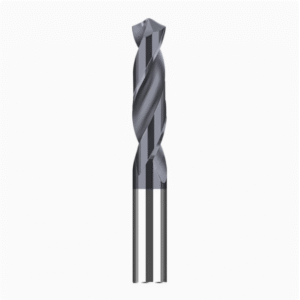
Critical Parameters for CNC Deep-Hole Drill Bit Selection
Even with high-performance carbide tipped drill bits, improper drill bit geometry or process parameters can lead to hole deviation, poor chip evacuation, and substandard surface finish. In CNC deep-hole drilling, determining the correct drill tip angle, flute design, coating type, and coolant system is essential to ensure machining stability, accuracy, and tool longevity.
Key factors in deep-hole machining include drill tip angle, spiral flute geometry, edge preparation, coating technology, and coolant routing. Optimizing these parameters improves drilling efficiency, prolongs tool life, and ensures consistent hole quality. For machining hardened steel or other high-strength alloys (carbide tipped drills for hardened steel) and long continuous drilling operations, proper selection is critical. For manufacturers procuring bulk carbide drill bits for B2B supply, standardized, well-matched drill solutions improve process consistency and reduce downtime and tool replacement costs.
Drill Point Angle and Cutting Edge Design
The drill point angle and cutting edge geometry directly influence drilling performance and hole quality. Selection depends on material hardness and hole depth:
-
Soft metals (e.g., aluminum, copper): A smaller point angle (90°–118°) reduces cutting resistance and enhances chip evacuation.
-
Hard metals (e.g., hardened steel, carbide-tipped drill bits for high-strength alloys): A larger point angle (130°–140°) minimizes edge wear and improves stability.
Edge honing and clearance angle treatments further affect hole surface finish and tool life. A moderate cutting edge radius prevents chipping and enhances cutting stability, while optimized back angles improve chip flow and reduce heat buildup. CNC deep-hole drills often use precision-ground cutting edges to maintain consistent hole diameter and smooth surface finish over long machining cycles.
Coating Selection: Advanced Coatings such as TiAlN and AlTiN
Coatings significantly enhance wear resistance, thermal stability, and oxidation resistance for carbide-tipped drill bits.
-
TiAlN coatings maintain stability above 800°C, ideal for high-speed or dry cutting environments.
-
AlTiN coatings improve heat dissipation and oxidation resistance, extending tool life in high-strength steel and stainless steel drilling.
For deep-hole CNC machining and bulk carbide drill bits for B2B supply, uniform coatings improve process consistency, reduce tool testing time, and enhance long-term productivity. Nanocomposite coatings such as TiSiN or AlTiN further improve cutting edge stability, surface finish, and thermal resistance, particularly for hardened steel applications.
Coolant System and Drilling Fluid Coordination
Efficient coolant delivery is critical in deep-hole drilling to prevent overheating, chip adhesion, or hole wall burns. Internal coolant channels in carbide-tipped drill bits deliver high-pressure coolant directly to the cutting edge, providing:
-
Reduced cutting temperatures and preserved sharpness;
-
Improved chip evacuation and prevention of chip accumulation;
-
Extended tool life and better hole surface quality.
For blind holes or specific materials, external coolant sprays may complement internal systems. Adjusting coolant viscosity and flow rate based on material and hole depth further optimizes performance. A stable cooling strategy in CNC machining drill bits also reduces wear and improves hole accuracy in B2B bulk production.
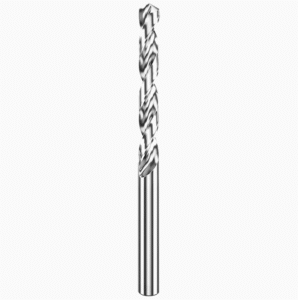
Bulk Procurement & Customization of Carbide Drill Bits for B2B
For machining companies and CNC component manufacturers, selecting the right carbide-tipped drill bits impacts not only single-piece machining efficiency but also overall cost control and lead time for mass production. In B2B procurement scenarios, companies must balance standardized drill specifications, inventory management, and OEM customization to meet the diverse needs of equipment and workpiece materials, including stainless steel, hardened steel, and cast iron.
An increasing number of manufacturers are opting for bulk carbide drill bit supply and long-term partnerships to achieve higher cost-effectiveness and a more stable supply chain. With the rise of digital supply chains and automated warehousing, B2B customers are also focusing on improving drill bit traceability, lifespan monitoring, and tool recycling, enhancing production efficiency throughout the tool lifecycle.
Specification Selection & Inventory Management
Appropriate specification planning is key to maximizing tool utilization and minimizing inventory pressure. B2B customers typically select different drill types based on drilling depth, workpiece material, and machine spindle power, such as common 3D, 5D, or 8D deep-hole drills.
To meet diverse requirements, companies should establish unified standards for shank diameters (straight shank, Morse taper), tip angles (118°, 135°), and coatings (TiAlN, AlCrN). Establishing reliable supplier partnerships and enabling dynamic inventory replenishment can reduce downtime risks and enhance supply chain flexibility.
OEM Customization & Branded Production Trends
As the manufacturing industry shifts toward high-mix, low-volume production, standard drills may not meet all specific work conditions. OEM customers increasingly prefer customized tip geometries, cutting edge structures, and internal coolant hole designs tailored to workpiece materials and machining paths.
Some B2B buyers also incorporate private label strategies into OEM partnerships, enhancing brand recognition and market competitiveness through customized packaging, laser marking, and parameter configuration. Offering CNC machining drill bit customization services has become a critical differentiator for suppliers.
Cost-Effectiveness & Lifecycle Management
One of the main concerns for B2B customers is balancing tool cost and lifespan. While carbide-tipped drill bits have a higher initial cost than HSS drills, their extended life, higher cutting efficiency, and less frequent replacement can significantly reduce overall unit costs.
To further improve efficiency, many companies implement tool lifecycle management systems. By monitoring wear and replacement cycles, they enable data-driven maintenance and regrinding. This reduces waste and ensures that every drill operates at optimal performance, generating substantial long-term returns.
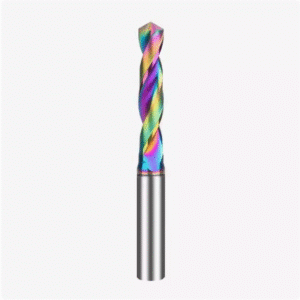
Practical Tips & Maintenance for Deep Hole Drilling
Deep hole drilling challenges both tool performance and operator expertise. Even with high-quality carbide-tipped drills, improper cutting parameters, cooling methods, or workpiece fixturing can lead to drill breakage, hole deviation, and poor chip evacuation. To maximize performance and extend tool life, process parameter optimization, wear monitoring, and routine maintenance are essential.
Stable feed control, proper coolant pressure, and regular inspections are critical in CNC precision drilling. Scientific maintenance and data-driven monitoring help reduce tool wear and maintain consistency in mass production.
Avoiding Drill Breakage & Hole Deflection
Drill breakage and hole deviation are common risks in deep-hole drilling. Causes include excessive feed rates, uneven cutting forces, and unstable clamping. Pre-drilling pilot holes ensures accurate positioning and reduces initial stress on the main drill.
For hard materials, step drilling and intermittent peck drilling prevent chip blockage and excessive forces. Proper drill point angles and high-rigidity clamping systems further reduce hole deviation and vibration, improving stability.
Drill Wear Assessment & Regrinding Cycle
Assessing wear ensures consistent machining. Signs include increased nose radius, blackened chips, higher noise, larger hole diameter, or poor surface finish. Carbide-tipped drill wear often appears as micro-cracks, flank wear, or cutting edge chipping.
Regrind drills before reaching critical cumulative cutting length or workpiece count to prevent tool failure or poor accuracy. Regrinding should maintain original geometry and coating to restore sharpness and heat resistance, extending tool life and improving efficiency.
Operational Recommendations for Prolonging Tool Life
To maximize carbide drill life:
-
Set spindle speed and feed rate according to material properties; avoid sudden acceleration or dry cutting.
-
Use internal coolant systems for effective heat reduction and chip evacuation; ensure external coolant, if used, is accurately applied.
-
Optimize drilling path, cutting depth, and retraction frequency to reduce uneven tool load.
-
Regularly clean toolholders and check runout to prevent vibration and thermal deformation.
This comprehensive approach enhances drill stability, improves machining accuracy, and significantly extends tool lifespan, increasing economic benefits for B2B bulk carbide drill bit users.
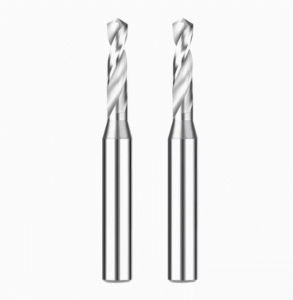
Efficient Deep-Hole Drilling Begins with the Right Carbide-Tipped Drill
Deep-hole drilling demands high performance from both tools and machining strategies, as well as precise coordination of cooling systems. Achieving a balance between precision, efficiency, and cost starts with selecting the right carbide-tipped drill. Every detail—from tool material and geometry to coatings and cooling design—directly affects machining stability, efficiency, and cost-effectiveness.
Carbide-tipped drills offer high hardness, excellent wear resistance, and exceptional thermal stability, delivering performance advantages far beyond traditional HSS drill bits. Their sharp cutting edges and rigidity ensure stable cutting in difficult-to-machine materials such as hard steel, alloy steel, and stainless steel. They also reduce the risk of drill breakage, hole deflection, and overheating.
In CNC machining and large-volume production (bulk carbide drill bits for B2B supply), precise parameter settings and optimized cooling control allow these drills to maintain consistent hole diameters and superior surface finishes. This provides manufacturers with higher production stability, improved yields, and lower downtime.
Moreover, the rise of OEM and customized tooling solutions enables companies to optimize drill geometry and coatings for specific applications, such as deep-hole drilling, hard steel machining, or complex component drilling. When combined with effective tool maintenance and regrinding cycle management, this approach extends tool life and reduces overall manufacturing costs.
In short, successful deep-hole drilling depends not only on process parameters and equipment but also on selecting the right drill bit. By carefully evaluating the material properties, design parameters, and supply options of carbide-tipped drills, manufacturers can achieve higher productivity, better cost control, and consistent machining quality. Efficient deep-hole drilling starts with the right drill bit selection and builds a stable, economical, and high-performance processing system.



